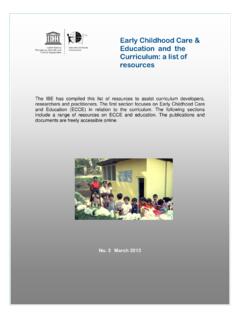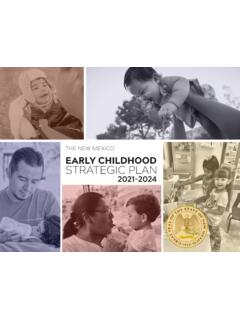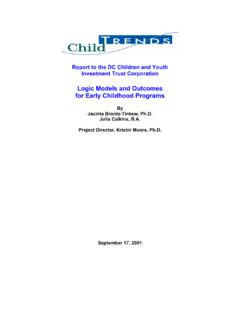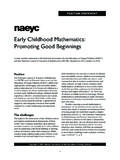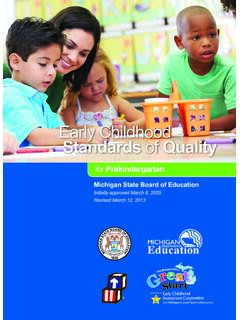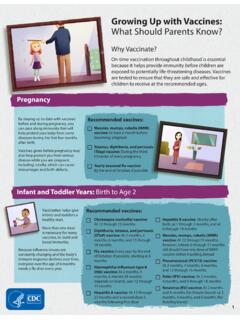Transcription of EARLY CHILDHOOD ASSESSMENT: IMPLEMENTING …
1 A research-based guide to inform assessment planning in the EARLY gradesMARCH 2013 Cindy Jiban, CHILDHOOD assessment : IMPLEMENTING EFFEC TIVE PRAC TICEE arly CHILDHOOD assessment : IMPLEMENTING effective Practice 2 TABLE OF CONTENTSI ntroduction 1 Reviewed Guidelines 1 Big Ideas Shared Across Documents
2 2 Challenges in EARLY CHILDHOOD assessment 2 The Case for Evidence-Based EARLY Intervention: Prevention as Better Leverage 4 Pursuing Assessments for EARLY Learning and Intervention 6 Building an EARLY CHILDHOOD assessment Plan 9 Putting It All Together 13 References
3 14 Appendix 16 About the AuthorCindy Jiban, in Educational Psychology, is a Senior Content Specialist for EARLY Learning at NWEA. Her primary interests are in intervention and assessment for students acquiring foundational academic Info 2013 by Northwest Evaluation Association NWEA expressly grants permission or license to use provided (1) the use is for non-commercial, personal, or educational purposes only, (2) you do not modify any information, and (3) you include any copyright notice originally provided in the CHILDHOOD assessment .
4 IMPLEMENTING effective Practice 1 INTRODUCTIONEven for professionals who make decisions about student assessment on a regular basis, the arena of EARLY CHILDHOOD assessment can be difficult to navigate. It is not enough to simply assess earlier content using the same approaches as those used in older grades, or to take decisions about tools and purposes that were made with older students in mind and extend them to younger children. Instead, professional standards and guidelines for EARLY CHILDHOOD assessment must begin with attention to the important reality that young children are continuously and rapidly developing, both academically and across a wide range of other domains.
5 The context that informs assessment decisions for EARLY learners is qualitatively different from the context for older students. The goal of this white paper is to support assessment and instructional leaders in planning or reviewing their assessment implementations in the EARLY grades. This paper will help readers: understand the big ideas EARLY CHILDHOOD thought leaders believe should guide assessment decisions for the youngest school-aged students (pre-kindergarten 3rd Grade) discover what the research shows to be effective in terms of assessment in the EARLY grades come away with a clear sense of next steps you can take to apply the research and best practices to your own assessment planning processIn preparing this paper, we reviewed and summarized key ideas from professional guidelines on EARLY CHILDHOOD assessment .
6 To frame our analysis of these guidelines, we also addressed two topics: 1) background on assessment -related concerns in the EARLY CHILDHOOD field and 2) evidence of the leverage that EARLY education and intervention provide on later outcomes. In this context, we closely examined professional recommendations relating to assessment purpose and assessment method. Finally, taking all of these important considerations into account, we compiled a set of questions to inform the assessment planning process in the EARLY grades. REVIEWED GUIDELINESFour seminal reports comprised the professional guidelines reviewed.
7 These focus, together, on children in pre-kindergarten through age 8. Key points from each document are included in the National Education Goals Panel (NEGP), 1998. In 1998, the NEGP convened a working group related to the following goal: By the year 2000, all children in America will start school ready to learn. This working group produced a document entitled Principles and recommendations for EARLY CHILDHOOD assessment . These principles are included in Appendix National Association for the Education of Young Children (NAEYC) and National Association of EARLY CHILDHOOD Specialists in State Departments of Education (NAECS/SDE), 2003.
8 In 2003, after the establishment of the No Child Left Behind law changed the Research and professional best practices show us that EARLY CHILDHOOD is a place of tremendous leverage, but it is also a place for tremendous care and consideration. Given the potentially massive impact of appropriate, quality educational programs and interventions for children at these tender ages, relying on the best sources of data to inform decisions is critical. [ ] EARLY CHILDHOOD assessment : IMPLEMENTING effective Practice 2landscape for educational assessment , NAEYC and the NAECS/SDE jointly drafted a position statement entitled EARLY CHILDHOOD Curriculum, assessment , and Program Evaluation.
9 Key assessment recommendations and indicators of effectiveness from this document are included in Appendix Division for EARLY CHILDHOOD (DEC), 2007. In 2007, the DEC of the Council for Exceptional Children developed a response to the 2003 position statement from NAEYC and NAECS/SDE. The DEC document highlights considerations for children with disabilities, but encompasses recommendations applicable to the broader community of which these children are members. The paper is called Promoting Positive Outcomes for Children with Disabilities: recommendations for Curriculum, assessment , and Program Evaluation.
10 Key recommendation and critical attributes from this document are included in Appendix National Research Council (NRC), 2008. The National Research Council (NRC) was commissioned to study important developmental outcomes for children through age 5 and to guide the appropriate assessment of these outcomes. In their 2008 book, EARLY CHILDHOOD assessment : Why, What and How, the NRC committee emphasized several essential principles. The NRC Guidelines on Purposes of assessment , Instrument Selection and Implementation, and Systems are included in Appendix D. BIG IDEAS SHARED ACROSS DOCUMENTSFrom these guiding documents, three big ideas emerged as central concerns for all of the authoring groups.

